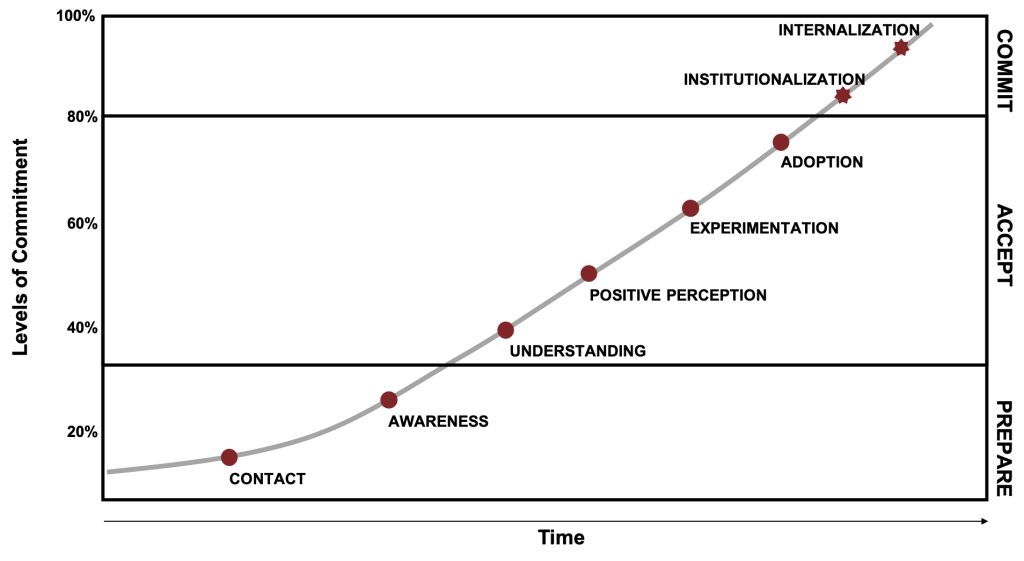Collaboratory’s Theory into Practice (TIP) series bridges the gap between scholarship and application by introducing theories, models, and frameworks that community engagement administrators and practitioners can use in their everyday work.
Rome wasn’t built in a day.
It required the buy-in of diverse stakeholders, each with varying needs, pressures, and perspectives. This short proverb drives home the point that important work takes time.
So how do you begin to engage people and lead them toward the change you seek?
Conner and Patterson (1982) developed The Commitment Curve as a model to explain how an individual’s commitment to major new organizational requirements increases over time. The model suggests that the degree of support individuals display for new mindsets or behaviors passes through three broad developmental phases: Preparation, Acceptance, and Commitment.
This model can serve as a useful tool for engagement practitioners working to collect data on engagement and service by providing suggestions on how to move people along the path to commitment. Let’s explore the phases using a community engagement data collection initiative as our change effort.

Prepare
This phase prepares people for change by making them aware of what the change is and why it is occurring. Consider a variety of communication efforts to ensure you are addressing the various stakeholders across your institution and at the appropriate times. We provide templates and resources for Collaboratory Administrators embarking on this phase at rollout.
Craft messages that:
- Provide a set of definitions or criteria that faculty and staff can use to judge whether their work is considered “engaged” by the institution
- Help faculty and staff realize the benefit of collecting this data to them personally, in addition to the benefit to the institution
- Prepare for the three essential questions: Why, What, and How
Accept
At this phase, you must help faculty and staff understand what specifically is expected of them and how it will affect them directly. If your communications have been successful, they should have provided faculty and staff with enough information to judge the data collection effort, weigh the pros and cons relative to their position and context, and ultimately decide whether to participate. Remember that it is natural to ask questions, pose challenges, and seek additional information; this does not necessarily mean that faculty and staff are resistant to your efforts. Make sure that your message is clear, consistent, and pervasive so that as individuals engage over time they are receiving the same information as those before them.
During this phase, you might run into barriers that need to be addressed to ensure widespread acceptance of your efforts, such as promotion and tenure eligibility, alignment with other institutional priorities, or reporting burnout. Try to reframe these challenges as opportunities to refine your message and influence institutional identity and culture.
Commit
This phase actually implements the change and requires that faculty and staff integrate it into their lives. This may start with faculty and staff exploring your data collection instrument, or providing just a small portion of the required data to see how the process works, but will hopefully lead to them actually satisfying your request for data.
As time passes, and if your communications and efforts have remained steady, you may reach a critical mass of participation that begins to shape the perception that providing community engagement data is now standard as part of annual reporting processes. This “institutionalization point” is still a reaction to external pressures – a goal even beyond this is internalization, where faculty and staff truly believe in your purpose, which motivates them not only to consistently participate in the long-term, but also to advocate for and protect the effort with others.
A few important notes:
- Approximately 80% of change efforts will happen in the first two phases before you ever begin implementing the change. This highlights that planning, preparation, and communication are critical to success. It is only in the last 20% of your efforts that you may actually request and succesfully collect any data from faculty and staff.
- This progression typically happens at different paces for different people, with many opportunities (stages) for advancement or attrition as they learn about your initiative and what it requires of them.
- While this process appears linear, there are cyclical aspects that require you to renew the messaging and reinvigorate the call to action to provide data. This will typically fall in line with annual reporting communications so that you can encourage faculty and staff to continue providing information year after year.
Contact Us!
Connect with us to learn more about how to develop and successfully implement change efforts around your institution’s community engagement and public service data.
